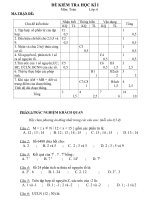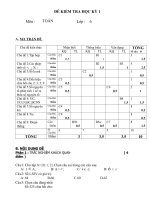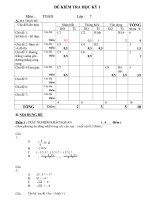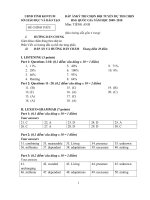click vào chữ read more để xem toàn bài và có thể download 1 bộ bài học internet marketing tiếng anh tuần 1 tuần 2 tuần 3 tuần 4 tuần 5 tuần 6 tuần 7 tuần 8 tuần 9 tuần 10 tuần 11 tuần 12 tuầ
Bạn đang xem bản rút gọn của tài liệu. Xem và tải ngay bản đầy đủ của tài liệu tại đây (92.11 KB, 19 trang )
<span class='text_page_counter'>(1)</span><div class='page_container' data-page=1>
Internet Marketing Strategy
</div>
<span class='text_page_counter'>(2)</span><div class='page_container' data-page=2>
Objectives
• Defining the business model
• Integrating Internet marketing strategy
• Levels of web development
</div>
<span class='text_page_counter'>(3)</span><div class='page_container' data-page=3>
Defining The Business Model
• the first determinant of a firm’s
performance is its business model
• the method by which a firm builds and uses
its resources to offer its customers better
</div>
<span class='text_page_counter'>(4)</span><div class='page_container' data-page=4>
Determinants of Business
Performance
<b>Business Model</b>
•Components & linkages
•Dynamics
<b>Environment</b>
•Competitive
•Macro
<b>Change</b>
•Properties
</div>
<span class='text_page_counter'>(5)</span><div class='page_container' data-page=5>
Internet Business Models
• Given such landscape-transforming
properties of the Internet, the question is,
How can a firm take advantage of them and
make money.
• The Internet business model is the system –
components, linkages, and associated
</div>
<span class='text_page_counter'>(6)</span><div class='page_container' data-page=6>
Internet Business Models
• It takes advantages of the properties of the Internet
in the way it builds each of the components – value,
scope, revenue sources, pricing, connected activities,
implementation, capabilities, and sustainability – and
crafts the linkages among these components.
• Categorized as pure play or clicks-and-mortar
– Pure play Internet business model - if firm does not have a
bricks-and-mortar model.
</div>
<span class='text_page_counter'>(7)</span><div class='page_container' data-page=7>
Properties of the Internet and the
5-Cs
<b> Internet Properties</b>
•Mediating technology
•Universality
•Network externalities
•Distribution channel
•Time moderator
•Information
asymmetry shrinker
•Infinite virtual capacity
•Low cost standard
</div>
<span class='text_page_counter'>(8)</span><div class='page_container' data-page=8>
Determinants of Firm Performance
Business Model
•Customer value
•Scope
•Price
•Revenue sources
•Connected activities
•Implementation
•Capabilities
•Sustainability
Internet
Environment
</div>
<span class='text_page_counter'>(9)</span><div class='page_container' data-page=9>
Taxonomy of Business Models
• Brokerage model – firms act as market makers who
bring buyers and sellers together and charge a fee for
the transaction that they enable.
• Advertising model – the owner of a web site provides
some content and services that attract visitors. Charge
advertisers fees for banners, permanent buttons …
• Infomediary model – a firm collects valuable
</div>
<span class='text_page_counter'>(10)</span><div class='page_container' data-page=10>
Taxonomy of Business Models
• Merchant model – is the “e-tailer” model in which
wholesalers and retailers sell goods and services
over the Internet.
• Manufacturer model – try to reach end users directly
through the Internet instead of going through a
wholesaler or retailer.
• Affiliate model – a merchant has affiliates whose
websites have click-through to the merchant.
</div>
<span class='text_page_counter'>(11)</span><div class='page_container' data-page=11>
Taxonomy of Business Models
• Subscription model – access to a web site is
not free. Members pay a subscription price
and in return receive high-quality content.
• Utility model – firms pay as they go.
</div>
<span class='text_page_counter'>(12)</span><div class='page_container' data-page=12>
Internet Marketing Strategy
• Block Strategy – firm erects barriers around its
product market space by having inimitable
capabilities and lowering prices.
• Run Strategy – an innovator often has to run.
Running means changing some subset of components
or linkages or business models or reinventing the
whole business model to offer customers better value.
• Team-up Strategy – if a firm can not do it alone. Use
</div>
<span class='text_page_counter'>(13)</span><div class='page_container' data-page=13>
David Teece argued that two things
determine the extent to which a firm can
profit from its invention or technology:
</div>
<span class='text_page_counter'>(14)</span><div class='page_container' data-page=14>
Who Profits from Innovation
I
Difficult to make
money
II
Holder of
complementary assets
makes money
IV
Inventor makes money
III
Party with both
technology and assets
or with bargaining
power makes money
H
ig
h
L
ow
<b>Im</b>
<b>it</b>
<b>ab</b>
<b>ili</b>
<b>ty</b>
Freely Available
</div>
<span class='text_page_counter'>(15)</span><div class='page_container' data-page=15>
Strategies for Building Business Models
<b> I</b>
Run
<b> II</b>
Team-up
•Joint venture
•Strategic alliance
•Acquisition
Internal development
<b> IV</b>
Block
<b> III</b>
Block
Team-up
•Joint venture
•Strategic alliance
•Acquisition
H
ig
h
L
ow
<b>Im</b>
<b>it</b>
<b>ab</b>
<b>ili</b>
<b>ty</b>
Freely Available
</div>
<span class='text_page_counter'>(16)</span><div class='page_container' data-page=16>
Internet Technology Life Cycle
•Locate profit
site •Determine strengths and weaknesses of business model
•Build business model
•Defend
competitive
advantage
•Decide where in
the Internet value
network you
want to be
•Build capabilities
•Build network
•Invest in infrastructure
•Win customers
•Build brand name
</div>
<span class='text_page_counter'>(17)</span><div class='page_container' data-page=17></div>
<span class='text_page_counter'>(18)</span><div class='page_container' data-page=18>
Simple Framework for IMS development
Develop Internet
marketing strategy
Define Internet
marketing plan
Design site
Implement site
Monitor (metrics)
</div>
<span class='text_page_counter'>(19)</span><div class='page_container' data-page=19>
Strategic Marketing Planning Process
1. Mission
2. Corporate objectives
3. Marketing audit
4. SWOT analysis
5. Assumption
6. Marketing objectives & strategies
7. Estimate expected results
8. Identify alternative plans & mixes
9. Budget
Measurement and review
Phase 1
Goal setting
Phase 2
Situation
review
Phase 3
Strategy
formulation
</div>
<!--links-->









